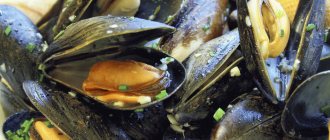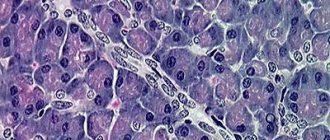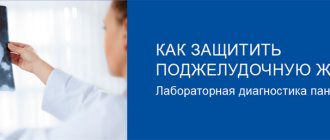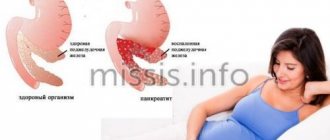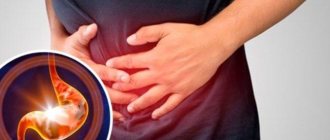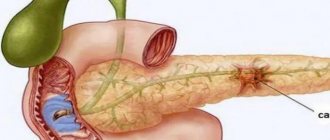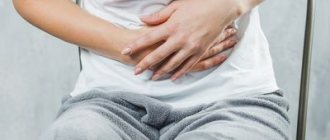Locked and dangerous
The pancreas performs several functions in the body.
One of them is the production of digestive enzymes that break down proteins, fats and carbohydrates that come with food. At first they are inactive; they begin to perform their duties only when, having passed along the pancreatic duct, they enter the duodenum. This is normal. If the duct is blocked for some reason, the enzymes remain locked inside the gland. Sooner or later they become active and begin to digest - but not food, but pancreatic cells. Inflammation develops, part of the gland is destroyed, and connective tissue forms in its place. This inflammation is pancreatitis. It can be acute or chronic. In the first case, o and is observed for a relatively short period. In the second, the iron is destroyed slowly, but over a long period of time.
Both scenarios are fraught with serious complications. No other organ is capable of taking over the work of the pancreas, so the death of its tissue (pancreatic necrosis) is an irreparable loss for the body.
The consequences of acute pancreatitis are directly related to the scale of destruction. Basically, it is small - in most people the inflammation is mild. But there are also cases when almost all the iron dies. They are incompatible with life.
The most important function of the pancreas is the production of insulin, which is necessary to control blood sugar levels. The fewer cells involved in its production, the higher the risk of diabetes. It is often observed in the later stages of chronic pancreatitis. Another formidable complication is pancreatic cancer: one of the most aggressive oncological diseases, which modern medicine is practically unable to cure. This is why problems with the pancreas cannot be ignored.
Faces of illness
In acute cases, it is difficult not to notice pancreatitis. Severe pain in the upper abdomen, radiating to the back (such pain is called shingles), vomiting that does not bring relief, rapid heartbeat - all these are symptoms of inflammation that has begun in the pancreas. If acute pancreatitis causes complications, the temperature may rise on the 3rd–5th day after the onset of the disease. But until this time it is better not to endure it and consult a doctor at the first manifestations of the disease. After all, if an exacerbation occurs in a moderate or severe form, it can end in suppuration and even peritonitis.
Signs of chronic pancreatitis are less obvious. About 30–40 minutes after eating, you may experience abdominal pain, mild nausea, and decreased performance. People often lose weight, although they eat enough and with appetite. They suffer from flatulence and diarrhea. However, chronic pancreatitis sometimes occurs without symptoms, so a person becomes aware of its presence only when an exacerbation occurs. It is not much different from the manifestations of an acute form of the disease.
If you or someone close to you has such an attack, immediately call an ambulance. While she is driving, lie down, try to relax your abdominal muscles and apply a heating pad with cold water to the sore spot. You cannot take painkillers - this will only blur the clinical picture. It is also forbidden to eat or drink water. In mild cases, the main principle of treating pancreatitis can be expressed in three words - cold, hunger and rest. You will have to abstain from food for several days; only still mineral water, rose hip decoction and weak tea are allowed. Bed rest and cold compresses on the upper abdomen are required.
However, this does not mean that you can cope with acute pancreatitis on your own. Treatment should be carried out in a hospital. It is necessary for a doctor to monitor your condition in order to notice complications in time. In addition, it is the doctor who must prescribe medications that help relieve the attack. These are painkillers and antispasmodics, enzyme and antacid drugs. If there is a threat of suppuration, antibiotics are used. For pancreatic abscess and extensive pancreatic necrosis, surgical intervention is necessary. The operation can be either abdominal or laparoscopic - it all depends on the patient’s condition and indications.
Hunger, cold and rest - how to protect the pancreas
Every year, diseases of the digestive system become more common. According to statistics, 16 out of 100 people suffer from such diseases. Peptic ulcers, gastritis and colitis are twice as common today as they were 10 years ago. But the leading position on this list is occupied by pancreatic disease. Moreover, young people began to get sick much more often. Advice on the prevention of pancreatitis and behavior when the disease appears is given by Nina Bogdanova, Deputy Chief Physician for Surgery of the State Budgetary Healthcare Institution of the KBSMP.
On the same level as an ulcer
— Nina Viktorovna, let’s first figure out what acute pancreatitis is? - This is a dangerous disease of the pancreas. The mild form of pancreatitis occurs with minimal damage to organs and systems, is expressed mainly by chronic swelling of the gland, is easy to treat and gives a favorable prognosis for a quick recovery. The severe form of acute pancreatitis is characterized by the development of pronounced disorders in organs and tissues or local complications, in particular, tissue necrosis, infection, cysts, abscesses. Acute and fulminant disorders of pancreatic function are often fatal for humans.
— Please tell us what function the pancreas performs in the body? - It plays an important role - before food enters the small intestine, the necessary amount of pancreatic secretion is supplied there through the internal ducts: enzymes involved in processing the food eaten, insulin, which lowers blood sugar levels. Thanks to this well-functioning mechanism, the body receives all the necessary microelements, amino acids, and proteins from food. Therefore, diseases of the pancreas, which include pancreatitis, can seriously disrupt the normal functioning of the entire body. Unfortunately, the life of a modern person is not just based on violating the principles of proper and rational nutrition, but also often challenges the most valuable thing - health. Diseases of the digestive tract are spreading across the planet at incredible speed. Medical statistics show that out of 100 people, 16 suffer from such diseases. Gastritis, peptic ulcers, and colitis have doubled over the past decade. It is pancreatic disease that occupies a leading position on this list. Even in the last century, acute pancreatitis was a rare occurrence. Now this disease is on the same level as stomach ulcers.
- Why does this happen? - Because of our lifestyle - snacking on the run, overeating when we finally returned home from work and ate our hearts out, poor quality of consumed products, dyes, sweeteners, alcohol and, of course, stress. Nowadays, the number of chronic pancreatitis has doubled; young people have become sick much more often, and all this is only in the last thirty years. Deadly complications and dangerous consequences have become the rule, not the exception.
— Is it possible to live without a pancreas? — Patients often ask this question. Indeed, there are diseases in which it is necessary to remove the gland or most of it, for example, with cancer or other destructive processes. As a result, the body does not have the enzymes necessary for normal digestion. Today, advanced technologies in pharmacology have made it possible to synthesize analogues of pancreatic juice enzymes and synthetic insulin. Our patients, after organ removal, are forced to take these drugs for life.
Capture in the "ring"
— Why is exacerbation of pancreatitis dangerous? - A number of fatal complications in the early stages of the disease. Firstly, shock, which occurs due to the ingress of toxins and products of the pancreas, which is accompanied by unbearable pain that covers the patient in a “ring”. Secondly, there is a risk of peritonitis. The secretion of the pancreas begins to be discharged into the abdominal cavity and aggressively “burns” the organs and tissues. Thirdly, pancreatic necrosis. This is a violation of the gland under the influence of its own enzymes. Fourth, acute multiple organ failure, cerebral edema, intestinal bleeding as a result of intoxication. Mortality due to pancreatic necrosis throughout the world, despite developed technologies, is one of the highest - up to 83% and is associated with the lightning speed of development of fatal and irreversible complications. Late complications are also not reassuring. A patient who has suffered acute pancreatitis must remember that he is at risk for developing diabetes mellitus, anemia, ulcers, and cholecystitis. Periodic exacerbations of pancreatitis lead to a narrowing of the ducts that remove bile, to thickening and crystallization of bile, which can cause the development of jaundice and pancreatic cancer.
— How to recognize acute pancreatitis? What are the symptoms of the disease? — First of all, this is a pain syndrome, the pain can be localized in the epigastrium, left hypochondrium, have a girdling nature, and radiate under the left shoulder blade. It is permanent and worsens when lying on your back. After eating food, especially fatty, spicy, fried, alcohol, your health worsens. Nausea and vomiting are observed, which can be indomitable, contain bile, and do not bring relief. There is also an increase in body temperature, moderate jaundice of the sclera is observed, and rarely, mild jaundice of the skin. In addition, acute pancreatitis may be accompanied by dyspeptic symptoms (flatulence, heartburn, single loose stools). Clinical symptoms of acute pancreatitis are not easy to distinguish from other equally dangerous diseases, such as ulcer perforation, acute cholecystitis, appendicitis, without instrumental research methods.
Measure in everything
— Who is at risk? — Men, compared to women, are more susceptible to developing complications caused by pancreatitis. Many representatives of the stronger sex rarely go to doctors; they do this in extreme cases, when the disease is already advanced. Men are prone to alcohol abuse, which is the main cause of pancreatitis. In women, gallstone disease is much more common than in men - this is the main cause of the development of not only pancreatitis, but also cholecystitis. In addition, the body of the fair sex is more sensitive to hormonal changes, which can also trigger the disease. The development of the inflammatory process in the tissues of the pancreas is promoted by menopause, pregnancy and childbirth, and long-term use of certain hormone-containing medications.
— Why does pancreatitis occur in children? — Determining the cause of the development of the disease in children is quite difficult. But most often, factors contributing to the onset of the disease are damage to the pancreas resulting from surgery or injury, and genetic predisposition. Pancreatitis is often diagnosed in children with intestinal, pulmonary or mixed forms of cystic fibrosis. Food allergies, chronic foci of infection, difficulty in the outflow of digestive juice, mumps infection - all this and much more can lead to disturbances in the functioning of the pancreas in children. In any case, remember: only a doctor and the examinations prescribed by him will help determine the cause of the development of pancreatitis.
— How to protect yourself and your loved ones from this disease? — The main principle of prevention is measures in everything: both in nutrition and lifestyle, proper nutritious nutrition, timely consultation with a doctor, and dispensary observation. If you are diagnosed with “chronic pancreatitis” in remission, you should visit a doctor twice a year and undergo appropriate examinations. And acute pancreatitis should be treated only in a hospital - until the pain syndrome is completely relieved.
About the features of the diet for pancreatitis
In case of attacks of acute pancreatitis, doctors adhere to the rules: cold, hunger and rest. You must refrain from eating for at least three days. During this period, only water is allowed. This is exactly the period our body needs to fully restore lost functions. Therefore, without loading the pancreas with food, we give it the opportunity to recover to the proper extent during these three days.
After a three-day fast, it is recommended to restore balanced nutrition gradually. First of all, you should avoid eating fatty, spicy and fried foods. Alcohol in any quantity is dangerous. Coffee, seasonings and concentrated meat broths cause the pancreas to work harder, and, as a result, the attack may resume. It is also better to abstain from eating raw vegetables, sweets, and baked goods in the first few days after fasting. Lean meat, steamed, will satiate the stomach with minimal harm to the body, unlike smoked and semi-finished products loved by many. Doctors advise consuming no more than 20 grams of butter per day.
The diet should include low-fat fish and stewed vegetables. The food should be of a puree-like consistency, not hot, but not cold, and preferably steamed. It is advisable to divide meals into five or six meals, in small portions of 200-300 grams. It is recommended to adhere to this principle of fractional nutrition for six months so as not to provoke new complications.
Prepared by Elena Krasnova.
Previously on the site: During the pandemic, four thousand telemedicine consultations were conducted in Kuban
Vice-Governor of Kuban Anna Minkova: “Starting in 2022, we will begin the repair and construction of 55 medical institutions”
Where did he come from?
Pancreatitis can be caused by a birth defect in the pancreas, certain autoimmune diseases, or certain medications. The disease can be triggered by a number of infections, hepatitis B or mumps. But most often, inflammation of the pancreas is caused by alcohol abuse.
Alcohol itself has a bad effect on gland cells, causing their damage. In response to a “drink or two,” the concentration of enzymes in the digestive juice increases. It moves more slowly along the ducts and therefore can begin to act before reaching its destination. Moreover, alcohol causes spasm of the sphincter located between the pancreas and duodenum. Normally, it should allow enzymes into the intestines, but block the exit of digested food from it. After abusing alcohol, it may not open in time, blocking digestive juice in the ducts.
Scientists have calculated that in order to “earn” pancreatitis, a person must consume 150 g of alcohol daily in terms of pure alcohol for 10 years. This is 375 g of vodka, about 1 liter of wine or 3 liters of beer. Quite a lot. However, let's not forget: these are averages. For many, the reaction occurs faster. For some, it is enough to “abuse” just a few times to provoke an attack.
The most dangerous combination of alcohol with fatty, spicy, salty foods. That is why the maximum number of exacerbations occurs after the holidays, when we lean on alcohol and delicacies. Such food in itself is dangerous: doctors attribute the fact that the incidence of pancreatitis has been constantly increasing in recent years to the increase in consumption of fatty foods.
Another cause of an attack may be gallstone disease. If you draw a schematic diagram of the bile duct and pancreatic duct, they will look like rivers on a map. Both “streams” flow into the “sea” - the duodenum. In a small area in front of it, they “merge” together, forming a common channel. If a stone travels along the bile duct and gets into this part, it can block the “gate” to the pancreas, thereby causing stagnation of enzymes.
Article on the topic
The pancreas takes revenge on us for our mistakes
Causes of chronic pancreatitis
- Lesions of the gastrointestinal tract - biliary tract (bile ducts and gallbladder), cholelithiasis (cholelithiasis).
- Injuries of the pancreas, including surgical interventions.
- Damage to the stomach and duodenum.
- Diabetes.
- Diseases of the celiac trunk and its branches that feed the pancreas.
- Alcoholism.
- Smoking.
- High fat diet.
- Malnutrition.
- A persistent increase in the content of calcium ions in the blood.
- Cystic fibrosis.
- Hypertriglyceridemia (increased levels of triglycerides in blood plasma).
- Viral infections (mumps, hepatitis B).
- Endocrine diseases (hyperparathyroidism).
- Exposure to drugs (corticosteroids, estrogens, thiazide diuretics, azathioprine, cytostatics, tetracyclines, sulfonamides, etc.).
Prevent trouble
Rare and moderate alcohol consumption, a healthy diet, and physical activity are enough to keep the pancreas healthy. And one more thing: if you don’t want to get sick, quit smoking. All other things being equal, pancreatitis occurs in heavy smokers approximately 5 years earlier than in non-smokers. And the risk of developing tumors in the pancreas in smokers is 2-3 times higher.
It is necessary to follow all these rules even if an attack has already occurred. After it is removed, you will have to add a diet to everything else. From the diet you need to exclude everything fatty, fried, spicy, rich broths, smoked foods, soda and alcohol. You will also have to give up salt, milk, pure sugar, honey and jam for a while. Among the prohibited vegetables are cabbage, legumes, spinach and radishes. But soups and purees from other vegetables are welcome. Meat and fish should be low-fat varieties: lean beef, chicken fillet, turkey, pike perch, carp. Vegetables can only be consumed boiled or steamed and preferably pureed. Fruits – baked, in the form of jelly or compote. An important component of the diet should be well-cooked porridge, for example, buckwheat or oatmeal. Fermented milk products are allowed, but they should not be too sour. It is necessary to sit down at the table often and eat little by little. All these rules will help to avoid repeated attacks and maintain health.
